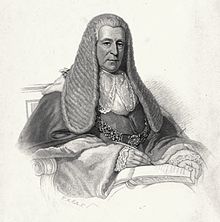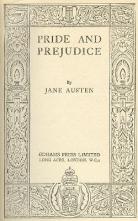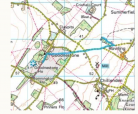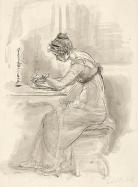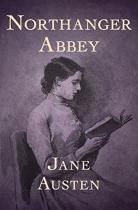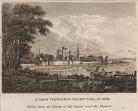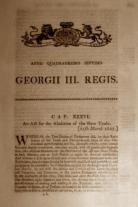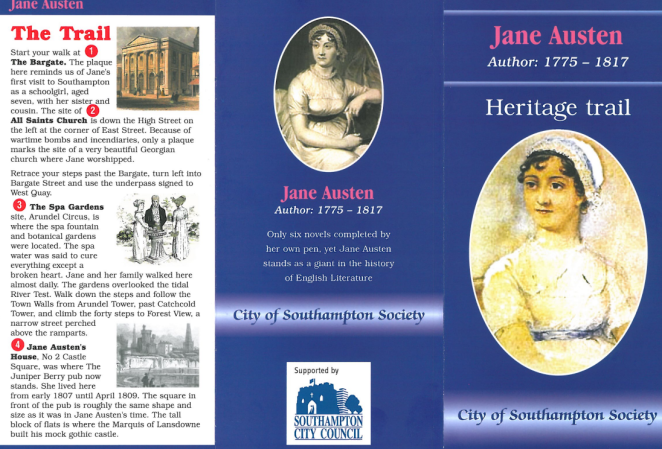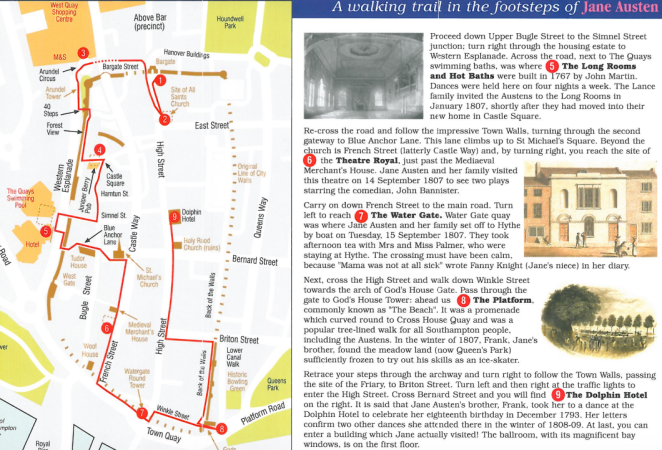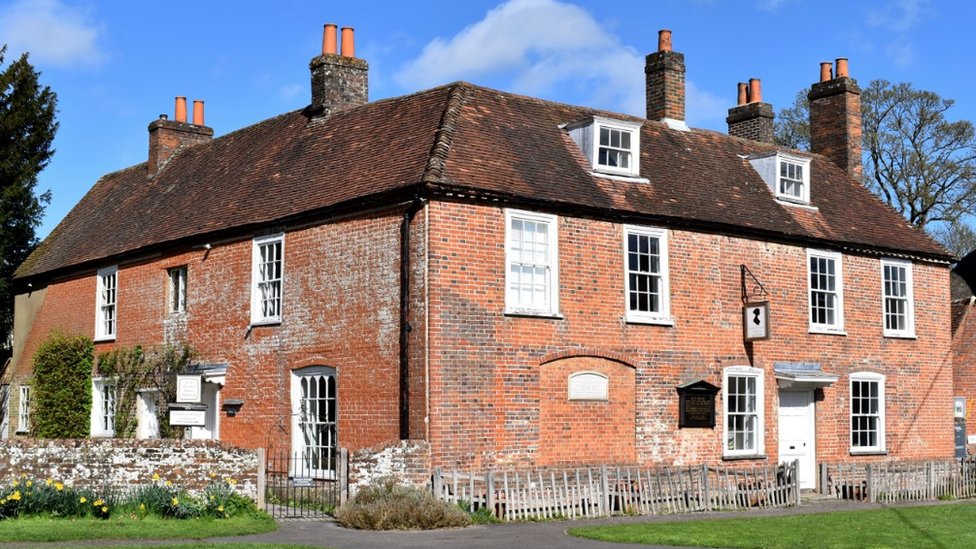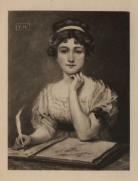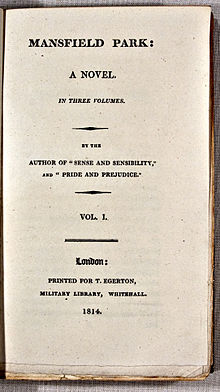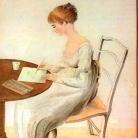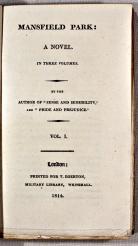Jane Austen Timeline
Created by Bettina Pedersen on Wed, 07/08/2020 - 19:15
Part of Group:
This timeline includes biographical details from Jane Austen's life. We will continue to build content relating to her novels, her life, and world events over the course of our reading and research together.
Timeline
Chronological table
| Date | Event | Created by | Associated Places | |
|---|---|---|---|---|
| 16 Dec 1775 |
Jane Austen's BirthThe date of Jane Austen's birth at Steventon, England
|
Bettina Pedersen | ||
| 5 Apr 1776 |
Jane Austen Is BaptizedAfter Jane Austen was born, she was baptized by her father, George Austen, just like her other siblings. She was baptized at the Steventon Rectory, and the formal ceremony happened on April 5, 1776 at St. Nicholas' Church. She attended church at St. Nicholas' Church, and her father was the reverend and rector of the church. Butler, Marilyn. Jane Austen, Oxford University Press USA - OSO, 2007. ProQuest Ebook Central, https://ebookcentral-proquest-come.pointloma.idm.oclc.org/lib/pointloma-.... |
Jasmin Segarra | ||
| 1783 |
EducationIn 1783, Jane and her sister Cassandra were sent to the town of Oxford to be educated by their Aunt Ann Cawley, the widow of one of the college heads. After developing and recovering from Typhus, the girls were sent to The Abbey Boarding School in Reading. Goldstein, Jack, and Isabella Reese. 101 Amazing Facts About Jane Austen. Andrews UK, 2014. EBSCOhost, search.ebscohost.com/login.aspx?direct=true&db=nlebk&AN=760372&site=ehost-live. Accessed November 10, 2020 http://pointloma.idm.oclc.org/login?url=http://search.ebscohost.com/logi... |
Anthony Calvez | ||
| 1789 |
Love & FriendshipAt the age of 14, Austen wrote a work to share with her friends and family. Her circle of friends and family were very literate and were very responsive to her early work, allowing her to gain feedback and experience. Love and Friendship, or Love and Freindship [sic], is a burlesque of popular sentimental novels. It tells the story of two young girls who, with the power of friendship, embark on a series of fun adventures. Todd, Janet. The Cambridge Introduction to Jane Austen, Cambridge University Press, 2006. ProQuest Ebook Central, https://ebookcentral-proquest-com.pointloma.idm.oclc.org/lib/pointloma-e.... Accessed November 11, 2020 https://ebookcentral-proquest-com.pointloma.idm.oclc.org/lib/pointloma-e... |
Anthony Calvez | ||
| 1795 to 1797 |
Jane Austen Writes "Elinor and Marianne"According to "Jane Austen and Her Time: A Brief Chronology" in Jane Austen's Pride and Prejudice edited by Robert P. Irvine, "Jane Austen writes 'Elinor and Marianne' in 1795" (33). |
Carmen Flores-Lopez | ||
| 1796 |
Flirtation with Tom LefroyJane Austen begins her romantic relationship with Tom Lefroy, who is the nephew of Austen's friend, Anna Lefroy. She had mentioned his name in letters that she wrote to Cassandra and some (sources?) recall that this relationship inspired the creation of her beloved characters of Mr. Darcy and Elizabeth Bennet. Source of this information? |
Camryn Ostrander | ||
| 1796 |
Pride and Prejudice NegotiationsAfter writing the novel Elinor and Marianna, Austen wrote First Impressions. Austen did not negotiate with publishers for herself until late in her career. Her father tried to help get an early version of Pride and Prejudice (First Impressions) published in 1796, but the publisher, Cadell, denied the manuscript without having read it. Bloom, Harold. Jane Austen's Pride and Prejudice. Facts on File, Inc, 1996. EBSCOhost, search.ebscohost.com/login.aspx?direct=true&db=nlebk&AN=38669&site=ehost-live. |
Jasmin Segarra | ||
| 1796 |
Austen at Rowling in KentIn August 1796 Jane went to visit her brother Edward and his wife, Elizabeth, at their first home, a large farmhouse at Rowling in Kent. Either while she was there or after she returned home that October, she began to write Pride and Prejudice under the title First Impressions, which was believed to be a response against Kent Hauteur. Butler, Marilyn. Jane Austen, Oxford University Press USA - OSO, 2007. ProQuest Ebook Central, https://ebookcentral-proquest-come.pointloma.idm.oclc.org/lib/pointloma-.... |
Jasmin Segarra | ||
| Nov 1797 |
Austen Begins Writing Sense & SensibilityAusten began writing Sense and Sensibility in November of 1797 based on her earlier draft of "Elinor and Marianne." She would not publish it for another 10 years due to family troubles, including the death of her father. Moody, Ellen. "A Calendar for Sense and Sensibility." Philological Quarterly, vol. 78, no. 3, 1999, p. 301. Gale Literature Resource Center, https://link.gale.com/apps/doc/A67710127/LitRC?u=sand82993&sid=LitRC&xid.... Accessed 17 Nov. 2020. https://link.gale.com/apps/doc/A67710127/LitRC?u=sand82993&sid=LitRC&xid... |
Anthony Calvez | ||
| 1801 |
BathAfter her father retired, Austen and her family moved from Steventon Rectory, the only home she'd ever known, to Bath, a city in the county of Somerset known for its Roman baths. "Austen, Jane." Merriam Webster's Encyclopedia of Literature, Merriam-Webster, 1995. Gale Literature Resource Center, https://link.gale.com/apps/doc/RN1480000739/LitRC?u=sand82993&sid=LitRC&.... Accessed 14 Oct. 2020. |
Anthony Calvez | ||
| Summer 1801 |
Failed EngagementJane Austen reportedly wound up romantically interested in a "young clergyman of highly congenial temperament" during the summer of 1801, when she was living in Bath. The unidentified man was meant to become engaged to Jane Austen, but she received word from his family that while the clergyman was away, he had passed away. Harman, Claire. "Austen, Jane (1775-1817)." British Writers, Retrospective Supplement 2, edited by Jay Parini, Charles Scribner's Sons, 2002, pp. 1-16. Gale Literature Resource Center, https://link.gale.com/apps/doc/CX1383100011/LitRC?u=sand82993&sid=LitRC&.... Accessed 6 Nov. 2020. |
Shane Hoyle | ||
| 1803 |
Austen Writes Northanger AbbeyNorthanger Abbey, written in 1803, was Austen's first completed novel, but it was published posthumously in 1817 along with Persuasion. In contrast with her other work, this novel comments and satirizes Gothic romance rather than fitting into the aesthetic of Regency literature we attribute to her other work. "Overview: Northanger Abbey." Novels for Students, edited by Ira Mark Milne, vol. 28, Gale, 2009. Gale Literature Resource Center, https://link.gale.com/apps/doc/H1430006641/LitRC?u=sand82993&sid=LitRC&x.... Accessed 17 Nov. 2020. https://link.gale.com/apps/doc/H1430006641/LitRC?u=sand82993&sid=LitRC&x... |
Anthony Calvez | ||
| 1805 |
Austen's Father DiesGeorge Austen, Jane Austen's father, passed away in Bath in 1805. The Austen family then moved to Southampton. Harman, Claire. "Austen, Jane (1775-1817)." British Writers, Retrospective Supplement 2, edited by Jay Parini, Charles Scribner's Sons, 2002, pp. 1-16. Gale Literature Resource Center, https://link.gale.com/apps/doc/CX1383100011/LitRC?u=sand82993&sid=LitRC&.... Accessed 6 Nov. 2020. |
Shane Hoyle | ||
| 1807 |
Austens Move to SouthamptonThe Austens move from Bath to Castle Square, Southampton. This is where Jane tries and fails to secure "Susan" for publication in 1809. Jane's older brother, Frank, lived in Southampton with his family, so therefore it made sense for his mother and his sisters to move in with them as well. Households often stayed together during this time to conserve the family money, help out with household items, etc. Austen, Jane. Mansfield Park, edited by June Sturrock, Broadview Press, 2003. |
Camryn Ostrander | ||
| circa. 25 Summer 1807 to circa. 1833 |
Abolition of Slave-TradeAccording to the British Library Organization, "In 1807, the British government passed an Act of Parliament abolishing the slave trade throughout the British Empire. Slavery itself would persist in the British colonies until its final abolition in 1838" (par. 1). Citation? |
Carmen Flores-Lopez | ||
| 14 Sep 1807 |
Jane Attends the Theatre RoyalWhen Jane and her family were in Southampton, they attended The Theatre Royal to enjoy two plays. Austen enjoyed theatre, and she utilizes her love for performances in her novels when her characters attend the theatre. She also would perform plays for her family in her house when she was growing up. Another interesting point about this theatre is that it was built by Mr. Collins, who was the proprietor. The same name was used for Elizabeth Bennet's cousin, Mr. Collins, in Pride & Prejudice. https://mistykrueger.com/2017/07/26/i-walk-the-line-the-southampton-jane...
|
Camryn Ostrander | ||
| 1809 to 1817 |
Chawton
Chawton Cottage
Image from https://www.bbc.com/news/uk-england-hampshire-48692299 Edward Austen provides a home for his mother and sister in Chawton in 1809, where Jane Austen spends the next eight years productively working on her literary pursuits. The source cited notes the specific texts including Pride and Prejudice, Mansfield Park, and Persuasion. According to the source's author, Claire Harman, "[Austen] began Mansfield Park and revised 'First Impressions' into Pride and Prejudice (the books were published in 1814 and 1813 respectively). Emma was written in 1814-1815 and published late in 1816; overlapping this was Persuasion, begun in 1815 and finished in 1816" (Harman 4). Her streak of productivity ends by 1816 where she begins indications begins showing signs of feeling ill. Harman, Claire. "Austen, Jane (1775-1817)." British Writers, Retrospective Supplement 2, edited by Jay Parini, Charles Scribner's Sons, 2002, pp. 1-16. Gale Literature Resource Center, https://link.gale.com/apps/doc/CX1383100011/LitRC?u=sand82993&sid=LitRC&.... Accessed 5 Nov. 2020. |
Shane Hoyle | ||
| 1809 |
Unexpected Publication SelectionAccording to the Broadview edition of Sense and Sensibility, "If upon settling in Chawton, publication was Austen's object, Sense and Sensbility was an unexpected selection. In 1809 she had the choice of at least three complete works in her possession and having already prepared "First Impressions" for consideration by a publisher, it should have been more likely choice than the more recently completed Sense and Sensibilty..." (10). |
Jasmin Segarra | ||
| 1811 |
The Reception of "Sense and Sensibility"
Sense and Sensibility was widley popular, and Austen was represented in a positive light by both liberal and conservative journals, showing that even if her novel depicted poilitical claims, she did so in a way that was so subtle, that her points and her style and competence were held at an equal standing in the eyes of both sides. Robert P. Irvine writes about the novel's public reception in depth in the following quote: "In fact the first edition sold out, and received an immediate, warm and extended review in the Critical Review of November 1811, as well as an equally positive if shorter notice in the British Critic in May the following year: the Critical Review was a liberal journal and the British Critic a conservative one, so this represented recognition from both sides of the political spectrum" (Irvine 48). Irvine, Robert P.. Jane Austen, Taylor & Francis Group, 2005. ProQuest Ebook Central, http://ebookcentral.proquest.com/lib/pointloma-ebooks/detail.action?docI.... |
Shane Hoyle | ||
| 1811 to 1820 |
RegencyThis is the time frame (1811-1820) when George III was still King but not "sane" so his son, the Prince of Wales, was made Regent (King-in-effect) so that the country would have a legitimate monarch who could act in matters of state for the incapacitated King George III. Prince Regent became King George IV when his father, George III, died in 1820. Jane Austen died in 1817, three years before the Prince Regent became king; thus over the course of her novels George III is King of England and his son is Prince Regent. In Austen's novel Pride and Prejudice, the Prince Regent's connection to Brighton figures importantly since the Prince was known for his excesses in spending and self-indulgence, In his association with Brighton as a vacationing spot, Brighton becomes a logical environment for the irresponsible behavior of Lydia in attaching herself to Wickham and in running off with him without being married to him. . |
Bettina Pedersen | ||
| 30 Oct 1811 |
Publication of Sense and SensibilityAdd description later. |
Bettina Pedersen | ||
| 1812 |
Pride & Prejudice Is Sold to a PublisherIn 1812, the copyright of Pride & Prejudice was sold to a publisher, Thomas Egerton for 110 pounds. The book would go on to be published the following year. Harman, Claire. "Austen, Jane (1775-1817)." British Writers, Retrospective Supplement 2, edited by Jay Parini, Charles Scribner's Sons, 2002, pp. 1-16. Gale Literature Resource Center, https://link.gale.com/apps/doc/CX1383100011/LitRC?u=sand82993&sid=LitRC&.... Accessed 17 Nov. 2020. https://link.gale.com/apps/doc/CX1383100011/LitRC?u=sand82993&sid=LitRC&... |
Anthony Calvez | ||
| 1812 to 1814 |
War of 1812According to "Jane Austen and Her Time: A Brief Chronology" in Jane Austen's Pride and Prejudice edited by Robert P. Irvine, "In 1812 the United Kingdom declares war on the United States" (32). According to the same source, this happens after Jane Austen's Pride and Prejudice has been offically published and before it goes to a second edition. (citation for source?) |
Carmen Flores-Lopez | ||
| 1813 to 1814 |
Jane Austen's Literary Career Earns Her an Income During Her Lifetime"[Jane Austen] had not expected to make any money from [Sense and Sensibility]; but the first printing sold out quickly, and she earned a small sum from the copyright. Sense and Sensibility was well received, as was her second novel, Pride and Prejudice, when it was finally published by Thomas Egerton in 1813. By the time her third novel, Mansfield Park, appeared in 1814, she was receiving a respectable income from her literary endeavors" (Klackle page?). Klackle, Natalie. "Jane Austen." Orientalist Writers, edited by Coeli Fitzpatrick and Dwayne A. Tunstall, Gale, 2012. Dictionary of Literary Biography Vol. 366. Gale Literature Resource Center, https://link.gale.com/apps/doc/H1200014301/LitRC?u=sand82993&sid=LitRC&xid=548e9125. Accessed 14 Oct. 2020. |
Carmen Flores-Lopez | ||
| 1813 |
JA Finishes Mansfield ParkIn the year 1813, Jane Austen finished her third novel Mansfield Park after starting it in 1811. Although she finishes her novel in 1813, she does not get it published until 1814, when it was published by Thomas Egerton. |
Camryn Ostrander | ||
| 1813 |
Publication of Pride and PrejudicePride & Prejudice (originally named First Impressions) was introduced as a second edition of Sense and Sensibility published by Egerton. Thomas Egerton gave Austen £110 for the rights of her book when she asked for £150. When she published Sense & Sensibility, she published it on a commission basis. She sold out of her first edition, which earned her £140, but she then sold Egerton the copyright in a one-payment, meaning he received all of the repercussions and the profit. Later, it was calculated that Egerton made around £450 from the first two editions of the novel.This novel was also not tagged with the author as "A Lady" but instead with "the Author of Sense and Sensibility." The novel was published around the same time as the Battle at Victoria, which closed up the Peninsular War in which Wellington was victorious in Spain and France was driven from Holland, Italy, and Switzerland (37). Austen, Jane. Mansfield Park, edited by June Sturrock, Broadview Press, 2003. “Pride and Prejudice.” Wikipedia, Wikimedia Foundation, 18 Nov. 2020, en.wikipedia.org/wiki/Pride_and_Prejudice. |
Camryn Ostrander | ||
| Jan 1814 |
Austen Writes EmmaAusten began writing Emma in January of 1814 and completed the book in March of 1815, about 14 months later. The book was eventually released in December of that year. Kelly, Gary. "Jane Austen." British Romantic Novelists, 1789-1832, edited by Bradford Keyes Mudge, Gale, 1992. Dictionary of Literary Biography Vol. 116. Gale Literature Resource Center, https://link.gale.com/apps/doc/H1200002367/LitRC?u=sand82993&sid=LitRC&x.... Accessed 17 Nov. 2020. https://link.gale.com/apps/doc/H1200002367/LitRC?u=sand82993&sid=LitRC&x... |
Anthony Calvez | ||
| 1 Jan 1814 |
Publication of Mansfield ParkMansfield Park was published on January 1, 1814. This novel was written after a ten-year break by Austen in which she dealt with the death of her father and her move from Bath to Southampton. After finishing and publishing both Sense and Sensibility and Pride and Prejudice, she wrote Mansfield Park. Stovel, Bruce. "Mansfield Park: Overview." Reference Guide to English Literature, edited by D. L. Kirkpatrick, 2nd ed., St. James Press, 1991. Gale Literature Resource Center, https://link.gale.com/apps/doc/H1420000397/LitRC?u=sand82993&sid=LitRC&x.... Accessed 17 Nov. 2020. https://link.gale.com/apps/doc/H1420000397/LitRC?u=sand82993&sid=LitRC&x... |
Anthony Calvez | ||
| May 1814 |
"Mansfield Park" First Edition Sells Out in 1814In 1814, Jane Austen published Mansfield Park and received substantial commercial success in the sales of the first edition. Robert P. Irvine suggests that the reputation of the anonymous author was the reason for the robust sales: "Mansfield Park was written in 1811–13, and published by Egerton in May 1814. It was not reviewed in any of the periodicals, and yet the first edition had sold out by November, presumably on the strength of being 'By the Author of Sense and Sensibility and Pride and Prejudice' alone" (62)." Irvine, Robert P.. Jane Austen, Taylor & Francis Group, 2005. ProQuest Ebook Central, http://ebookcentral.proquest.com/lib/pointloma-ebooks/detail.action?docI.... |
Shane Hoyle | ||
| 1815 |
Jane Austen Begins Writing PersuasionAccording to "Jane Austen and Her Time: A Brief Chronology" in Jane Austen's Mansfield Park edited by June Sturrock, "Jane Austen begins working on Persuasion in 1815" (33).
|
Carmen Flores-Lopez | ||
| Autumn 1815 |
Austen Offers Fourth Novel to John Murray & Mansfield Park, and It Gets Published on Standard CommissionThis source elaborates on the process of getting her fourth novel Emma published. Upset by Egerton's lack of attention, she offered her novel Emma to John Murray in August or September of 1815. "Henry Austen protested at the poor terms in November: it was agreed that second editions of Mansfield Park and Emma would both be published on standard commission" (60). Butler, Marilyn. Jane Austen, Oxford University Press USA - OSO, 2007. ProQuest Ebook Central, https://ebookcentral-proquest-com.pointloma.idm.oclc.org/lib/pointloma-e.... |
Jasmin Segarra | ||
| Dec 1815 |
Emma
ArticlesAnne Wallace, “On the Deceased Wife’s Sister Controversy, 1835-1907″ |
David Rettenmaier | ||
| 1816 |
Jane Falls IllAusten began to develop symptoms of what may have been Addison's disease. Klackle, Natalie. "Jane Austen." Orientalist Writers, edited by Coeli Fitzpatrick and Dwayne A. Tunstall, Gale, 2012. Dictionary of Literary Biography Vol. 366. Gale Literature Resource Center, https://link.gale.com/apps/doc/H1200014301/LitRC?u=sand82993&sid=LitRC&x.... Accessed 16 Nov. 2020. |
Camryn Ostrander | ||
| 1816 |
Working Title: "The Elliots"According to the Broadview edition of Persuasion, the working title of this novel was "The Elliots" (page?). The text explains that the decision to title her novel Persuasion was indeed her doing so. |
Jasmin Segarra | ||
| circa. 1817 to circa. 1818 |
Debate Surrounding Jane Austen's Illness at 40/41According to A. Upfal's "Jane Austen’s Lifelong Health Problems and Final Illness: New Evidence Points to a Fatal Hodgkin’s Disease and Excludes the Widely Accepted Addison’s," Austen most likely suffered from Hodgkin's disease along with an autoimmune disease (page?). This stands in direct contrast with what other Austen scholars like Deirdre Le Faye conclude, “[that] up to the end of 1815, Jane had been remarkably free from ailments” (page?). Upfal goes on to further state that "[b]iographers have also tended to follow this line and ignore or trivialise previous episodes of illness that are documented in Jane’s letters" (page?). In fact, Upfal asserts that "...a medical history is threaded through the surviving Austen letters, which reveals that she suffered other, and unusually severe and debilitating illnesses, and was particularly susceptible to infection" (Upfal, par. 2). It is worth noting that the nature of Jane Austen's illness is far from settled, but what is certain is that she suffered from an illness that ultimately took her life at around age 40. |
Carmen Flores-Lopez | ||
| May 1817 |
Austen Moves to WinchesterAccording to her brother, Austen grew undeniably ill, and her family decided to retire her to Winchester in May 1817. By July, only two months later, Austen would pass away. |
Shane Hoyle | ||
| 18 Jul 1817 |
1817 Jane Austen Dies July 18A year earlier, Austen began developing symptoms attributed to Addison's disease. She died in Winchester on July 18, 1817 with her sister in attendance. Klackle, Natalie. "Jane Austen." Orientalist Writers, edited by Coeli Fitzpatrick and Dwayne A. Tunstall, Gale, 2012. Dictionary of Literary Biography Vol. 366. Gale Literature Resource Center, https://link.gale.com/apps/doc/H1200014301/LitRC?u=sand82993&sid=LitRC&x.... Accessed 19 Oct. 2020.
Gale Literary Resource Center, accessed October 19 |
Anthony Calvez | ||
| Dec 1817 |
Persuasion PublishedJane Austen wrote Persuasion from August 8, 1815 to August 6, 1816. The book sold in a collection and was not published until December of 1817, which is sometimes dated as 1818, about five months after her death. This image is from the original manuscript of Persuasion. Here is the link if anyone is interested: http://www.bl.uk/learning/timeline/item106326.html Gemmill, Katie. “Jane Austen as Editor: Letters on Fiction and the Cancelled Chapters of Persuasion.” Eighteenth Century Fiction, vol. 24, no. 1, Fall 2011, pp. 105–122. EBSCOhost, doi:10.3138/ecf.24.1.105. |
Anthony Calvez | ||
| 1818 |
Persuasion's Unique Style
Persuasion was published post-humously, but proves itself to be distinct from the other Austen works we have read thus far. Robert P. Irvine explains this as such: "Persuasion can appear as a move in new directions: darker, more pessimistic, readier to admit the value of passion and romance cut loose from the demands of society, it is often seen as anticipating the approach of later women novelists and in particular the Brontë sisters. In fact the inwardness of Persuasion, its greater concern with the thoughts and feelings of its heroine compared with the social situations in which she moves, is made possible by a mastery of narrative technique that Austen had been developing throughout her career, in particular the use of free indirect discourse..." (Irvine 39). Irvine, Robert P.. Jane Austen, Taylor & Francis Group, 2005. ProQuest Ebook Central, http://ebookcentral.proquest.com/lib/pointloma-ebooks/detail.action?docI.... |
Shane Hoyle | ||
| 1869 |
Caroline Austen Reveals S&S OriginAusten's niece, Caroline Austen, noted in 1869 that Sense and Sensibility was first told in letters: "Memory is treacherous, but I cannot be mistaken in saying that Sense and Sensibility was first written in letters, and so read to her family." This was well after Austen had passed; however, it is important to know that it was at first a beloved story told between letters and shared within the family, and it was soon loved by the whole world. Crossey, Paul. “Time Flies by in Sense and Sensibility.” Jane Austen Centre, 20 June 2011, janeausten.co.uk/blogs/jane-austen-books-and-characters/time-flies-by-in-sense-and-sensibility.
|
Camryn Ostrander |





